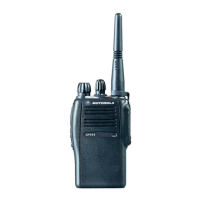v
• Hold the radio in a vertical position in front of the face with the microphone (and
other parts of the radio including the antenna) at least one inch (2.5 centimeters)
away from the nose or lips.
• Antenna should be kept away from the eye. Keeping the radio at a proper distance
is important since RF exposures decrease with increasing distance from the
antenna.
• When worn on the body, always place the radio in a Motorola-approved clip, holder, holster,
case, or body harness for this product. Using approved body-worn accessories is important
because the use of non-Motorola-approved accessories may result in exposure levels, which
exceed the FCC occupational/controlled environment RF exposure limits.
• If you are not using a body-worn accessory and are not using the radio in the intended use posi-
tion in front of the face, ensure the antenna and the radio are kept at least one inch (2.5 centime-
ters) from the body when transmitting. Keeping the radio at a proper distance is important
because RF exposures decrease with increasing distance from the antenna.
Approved Accessories
• Use only Motorola-approved supplied or replacement antennas, batteries, and accessories. Use
of Non-Motorola approved antennas, batteries, and accessories may exceed the FCC (IEEE)
and ICNIRP RF exposure guidelines.
• For a list of Motorola-approved accessories, visit the following website, which lists approved
accessories for your radio model: http://www.motrola.com/governmentandenterprise/
Additional Information
For additional information on exposure requirements or other training information, visit
http://www.motorola.com/rfhealth.
Electromagnetic Interference/Compatibility
NOTE:Nearly every electronic device is susceptible to electromagnetic interference (EMI) if
inadequately shielded, designed, or otherwise configured for electromagnetic compatibility.
Facilities
To avoid electromagnetic interference and/or compatibility conflicts, turn off your radio in any facility
where posted notices instruct you to do so. Hospitals or health care facilities may be using
equipment that is sensitive to external RF energy.
Aircraft
When instructed to do so, turn off your radio when on board an aircraft. Any use of a radio must be
in accordance with applicable regulations per airline crew instructions.
Medical Devices
Pacemakers
The Advanced Medical Technology Association (AdvaMed) recommends that a minimum separation
of 6 inches (15 centimeters) be maintained between a handheld wireless radio and a pacemaker.
These recommendations are consistent with those of the U.S. Food and Drug Administration.
Persons with pacemakers should:
• ALWAYS keep the radio more than 6 inches (15 centimeters) from their pacemaker when the
radio is turned ON.

